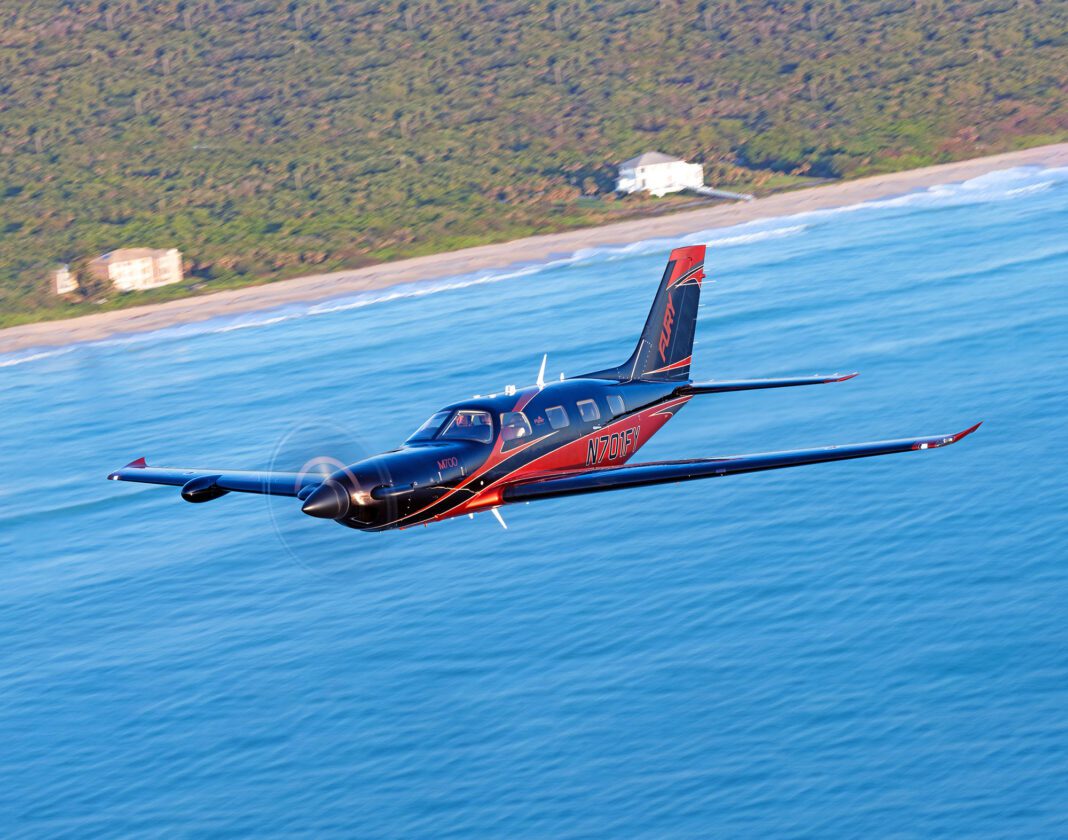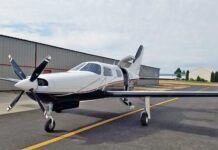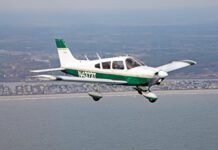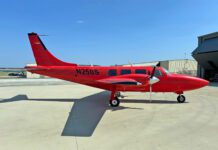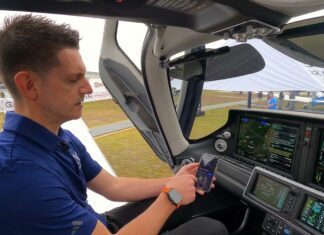Above: That’s the new Piper M700 Fury single-engine turboprop filmed by Leonardo Correa Luna. We always felt that the Piper M600 was a good climber, but the new M700 has bragging rights to a 2048 FPM max rate of climb at sea level, which is 30 percent greater than the M600. At 17,500 feet and holding max torque, it’ll turn true airspeeds around 291 knots burning 385 PPH.
In the early 1980s Piper was going after speed in a big way. At the end of 1983 it was delivering the PA-46-310P Malibu, a cabin-class, pressurized single that was faster than any piston single in the sky.
The next year it introduced the PA-42-1000 Cheyenne IV that had a max cruise of 351 knots, faster than the Cessna Citations of the day. When Lear Siegler bought Piper, the name was changed to the PA-42-400LS for its cruise speed in MPH and the new corporate owner. However, we who saw one of the 43 built go whistling by thought that LS stood for Lickety-Split.
Then the bottom fell out. Within two years Cessna quit building piston-engine airplanes and Piper watched the market for the Cheyenne slowly dry up.
Yet there were always buyers for the Malibu and its speed in the lower flight levels. In 1989 Piper made it faster, creating the PA-46-350T Malibu Mirage that cruised at 231 knots.

Meridian
However, about that time aftermarket entrepreneurs were dropping turboprop engines into piston singles. Despite their lack of range, they sold. Piper, not being foolish and having lots of turboprop experience, stepped into the fray by using a 500-HP PT-6 to create the 260-knot PA-46-500TP Meridian, which first reached customers in November 2000.
The Meridian began deliveries just before the close of the century—in November 2000. With a max cruise of 260 knots the Meridian was an immediate success.
Not willing to leave well enough alone and recognizing the payload limitations of the Meridian, Piper developed a new wing that could carry more fuel for the tried-and-true PA-46 fuselage, made numerous airframe tweaks, upped the horsepower to 600 and, in 2016, introduced the M600 while announcing that the PA-46 line would be known as the M-Class. We reviewed the M600 in September 2016 and noted its 50 percent range increase over the Meridian and cruise speed of 274 knots.
As one would expect, customers are never satisfied and called for more power, speed and useful load. Piper said, “Aye, aye,” and dropped even more puff—700 HP—into the airframe and certified the M700 (PA-46-701TP) earlier this year. This time Piper gave it a name that reflected its goal of speed and performance—Fury.
As the M700 breaks the 300-knot barrier for personal single-engine airplanes, the name Fury seems most appropriate. At $4.2 million nicely equipped, it’s within 5 knots of being as fast as the Cirrus Vision Jet.
The numbers
The fuselage is almost pure Malibu—the airplanes are put together on the same assembly line with some changes for the needs of the M700’s speed. Max differential pressurization is 5.5 PSI, giving an 8,244-foot cabin at FL280. The Pratt & Whitney PT6A-52 powerplant is flat-rated at 700 HP—which it can maintain up through FL240. It’s also used on the King Air 260 where it puts out 850 HP.
Max operating altitude is 30,000 feet. At FL250, max cruise is 301 KTAS on a standard day, where it burns 365 PPH (55 GPH). Usable fuel is 260 gallons (1,742 pounds). Piper advertises range at max cruise with 45-minute reserve as 1,149 NM. Slowing just 9 knots pushes the range up more than 200 NM to 1,424 NM. Pulling the power back to what one considers max cruise for many piston singles, 206 KTAS, bumps the range to 1,852 NM. Yes, we know, people are buying the M700 for speed because it’s always about speed—we suspect that M700s are going to spend a significant portion of their flying lives at or near 301 knots.
Climb
Max rate of climb at sea level—2,048 FPM—is 30 percent greater than the M600. The Fury can reach FL250 in 13.9 minutes. Welcome to power and a five-bladed prop that can convert it to thrust. It’s no surprise that with the introduction of the M700, Piper is phasing out the M600.
The M700 we flew had an empty weight of 3,855 pounds (it appeared to have every available option). That’s 125 pounds more than Piper advertises and 79 pounds more than the average for the first airplanes off the assembly line. With a maximum ramp weight of 6,050 pounds, the airplane we reviewed had a useful load of 2,195 pounds. Max takeoff weight is 6,000 pounds. With full fuel, 453 pounds can be carried in the cabin.
Landing Weight
Max landing weight is 5,800 pounds, so 200 pounds of fuel must be burned off after a gross weight launch. Max zero fuel weight is 5,050 pounds (any weight above 5,050 pounds must be in fuel). That allows for a maximum of 1,195 pounds to be carried in the cabin of the airplane we flew.
Filling the seats means watching individual weights, although it can come close to carrying six 200-pounders and no baggage. The airplane is designed to be owner-flown and it just isn’t that common for owner/pilots to fill the seats in their airplanes. For families with three or four kids, the airplane might be perfect if care is taken in how much stuff everyone carries.
With a max cabin load, 1,000 pounds (149 gallons) of fuel can be loaded. That’s nearly three hours of flying at low cruise settings.
When we ran some sample weight and balance problems, we noted that with full fuel and a partial passenger load, the center of gravity tended to stay near the middle of the envelope. However, with a full boat of passengers (we used 190 pounds each) and partial fuel, the airplane was loaded 1.37 inches aft of the aft limit—and that’s with no baggage. The takeaway—if you’re going to fill the cabin, load the heavier folks forward. Fortunately, with the G3000 avionics suite, summoning up the departure and landing weight and balance is a true piece of cake.

Avionics
Beyond the speed of the Fury, the major selling point is the stunning avionics suite that comes standard. It includes a Garmin 3000 system seamlessly integrated into the aircraft, a GFC 700 digital autopilot, autothrottle, GWX 75 weather radar, GDL 60 datalink, integrated digital cabin pressurization and the HALO safety system.
The HALO safety system includes Garmin’s emergency Autoland, a fully autonomous landing system that can be activated manually by anyone in the aircraft or automatically if the system senses pilot incapacitation. Once triggered, Autoland selects an appropriate airport for landing, notifies ATC of the emergency, keeps the occupants advised as to what’s going on, and lands the airplane—activating deicing equipment as needed, extending the flaps and gear when the time comes. It slows the airplane to a stop on the runway, shuts down the engine and instructs the occupants on safe exit from the airplane.
To our knowledge, Autoland has not been used in an emergency; however, as with saves with whole airplane parachutes, we think that it’s only a matter of time. In talking with Piper sales personnel, we were assured that the Garmin Autoland system has sold a number M700s.
Above 14,100 feet with the autopilot engaged, HALO monitors pilot interaction for signs of hypoxia. If it detects hypoxia, it will fly the M700 to a lower altitude while it continues to monitor pilot activity. If activity is not detected, it will automatically activate Autoland.

Level
Automatic Level Mode—a push button— returns the aircraft to a wings-level attitude with zero vertical speed. In addition, Electronic Stability & Protection (ESP) is monitoring when the airplane is being hand flown. Should selected pitch, bank and speed (high or low) parameters be exceeded, the system gently applies control forces to return the airplane to flight within the parameters.
The autothrottle is an integral part of the above systems, helping prevent overspeed or stall. We found that it was also handy on takeoff. Bring the power lever up to 800 pounds of torque and the autothrottle takes over and sets max torque (1,840 foot-pounds) so the pilot doesn’t have to futz with setting power while the Fury is zorching down the runway toward its 75-knot rotation speed—it gets there quickly.

Outside
Approaching the M700 Fury from head on its clean lines and five-bladed prop serve notice that this machine will cook. The exhaust stacks give the impression of speed—they’re subtly more swept and tapered than in other aircraft. We were advised that they help make the aircraft quieter than the M600 and the engine slightly more efficient.
The large cuff on the inboard leading edge of the wing helps the Fury meet the 61-knot maximum stall speed for single-engine airplanes and it, along with some fairings, are easily removable for maintenance. The cuff also allows for fuel lines from the wings to the engine to be routed outside of the fuselage pressure vessel, a big plus for crashworthiness. The two big non-icing NACA ducts under the nose deliver air to the engine without a need for ice vanes, inertial separator, or inlet de-icing. The large flaps have three positions: up, takeoff/approach and down.
Other than the shape of the exhaust stacks, the only noticeable exterior difference between the M600 and M700 is a Gurney flap—a low-drag, high-lift device from the auto racing world—on the left side of the rudder trim tab. As Piper chief of flight test Joel Glunt pointed out during our walkaround, adding more power to an airplane is destabilizing. To achieve the desired roll and yaw stability on the M700 the Gurney flap was added and rudder travel was increased.

Cabin
The cabin is fairly tight at 49.5 inches wide and 47 inches tall—one of the reasons the airplane is fast. Length from the aft pressure bulkhead to the instrument panel is 148 inches. As much as 100 pounds of baggage can be stowed behind the rear seats. They fold forward, but getting heavy suitcases in and out takes some effort. There is a provision for storing as many as three sets of golf clubs.
The quality of the interior appointments is first rate, in keeping with the demands of people who occupy the cabins of top-of-the-line turboprops. The seats are comfortable, the leather is beautiful, the colors available are impressive, and such amenities as cupholders and USB ports are in easy reach.
The M-series machines were not designed for tall people—they were designed to go fast. Once in the left seat my head (we’re 6’4” tall) was against the headliner even before putting on a headset. Legroom is only just adequate.

From a crashworthiness standpoint, the flight deck is, in our opinion, not satisfactory and not in keeping with a company that was in the forefront of occupant protection from the early 1960s with the Pawnee agplane. There is little flail space in the event of a quick stop, and there is an upper switch panel in front of each pilot that is likely to cause head injury during the most common type of general aviation aircraft accident—runway loss of control. The upper switch panel also restricts visibility upward in turns and steep descents.
We were dismayed at the flight deck restraint system—it’s a set of three-point belts that look like they came from an old Cherokee. They are not only jarringly out of place in the overall ambiance of the interior, they are, in our opinion, inadequate for an airplane with the Fury’s potential energy. For the tight space available for the pilots, we think airbag seatbelts should be standard equipment.
Flying It
Firing up the Fury is pure PT6—spin the engine, wait a moment, introduce fuel, and monitor as it lights off and comes up to speed. The G3000 boots up quickly. It will display whatever you need in the moment: checklist, synoptic pages showing systems status, taxiway routing, even synthetic vision on the ground while taxiing.
Once moving, the nosewheel steering is positive and predictable. There is enough thrust at idle due to prop pitch and the faired exhausts that it’s usually necessary to taxi in Beta with occasional forays into reverse.
Acceleration on takeoff is just plain exhilarating. Directional control was positive throughout with much less right rudder required than we expected. Published takeoff performance on a standard day at sea level is a ground roll of 1,261 feet and over an obstacle in 1,994 feet. From our perspective, that appeared to be accurate.
Rotation required only light back pressure but once the M700 broke ground significant nose-down trim was required immediately. We suspect that moving the gear aft with the new wing (for the M600 and M700) meant that setting takeoff trim was a tradeoff between control force required on rotation at 75 knots (as opposed to 85 knots for the M600) and the trim required for climb at Vy—122 knots.
In the initial climb, we saw a rate of 2,300 FPM, which was consistent with our weight and a published rate of 2,048 FPM at gross weight on a standard day at sea level. Handling was positive and lighter in pitch than expected for an airplane of this size with a downspring in the pitch control system. Max yoke deflection in roll is only 45 degrees, something that we predicted would make it easy to overcontrol as little control displacement is needed to deflect the ailerons. That was initially the case, but within a few minutes we adjusted to the pressure required to get the response desired—the airplane can be tossed around nicely.
Leveling at 17,500 feet and holding max torque, we observed a true airspeed of 291 knots burning 385 PPH. The book called for 284 KTAS while burning 390 PPH.
Descending below 10,000 feet to do airwork revealed that the M700 is rock solid in slow flight and just plain fun to fly in steep turns—the long nose helps with pitch control. The stall is a non-event, with lots of warning and a straight ahead, gentle pitch down.
Programming the Garmin automation for a descent and intercept for an ILS approach was as it usually is, dead easy. The autothrottle nailed programmed speeds and descent rates.
Disconnecting the autopilot and hand-flying the ILS revealed that the Fury stayed on its trimmed speeds nicely. The hydraulically actuated gear can come down at 170 KIAS, with approach flaps at 147 KIAS and full flaps at a surprisingly low speed, 112 KIAS. There is a noticeable pitch change with flap extension and retraction. Gear extension causes what we considered to be a surprising amount of yaw as the nosegear comes down.
Holding 85 KIAS on final, bringing the power lever to idle and making a good pull on the yoke gets the nose up smoothly for a 70-knot touchdown. Putting the nosewheel on the runway allows using reverse and that big prop stops the airplane rapidly without directional excursions.
Conclusion
We liked what we experienced in the M700 Fury—more performance in an airplane that is fun to fly matched with the most sophisticated avionics suite and safety automation available is quite a combination.

